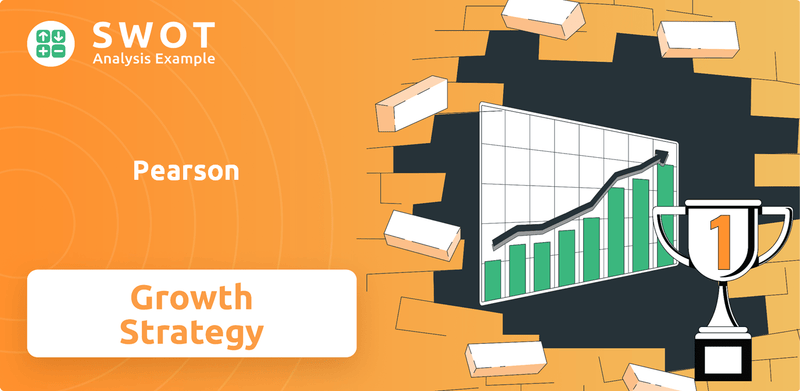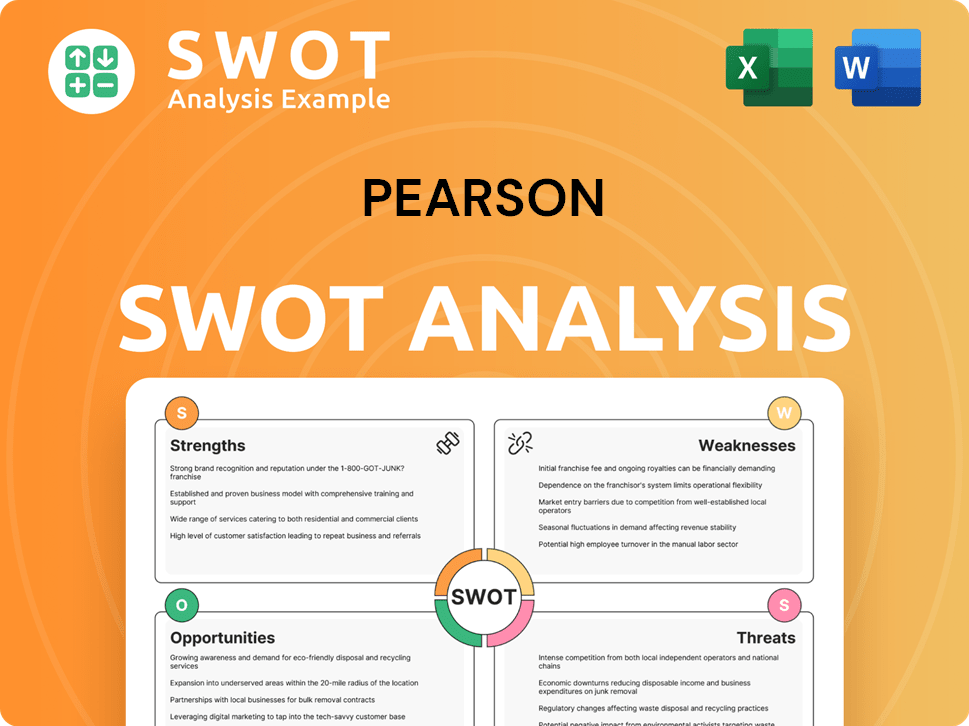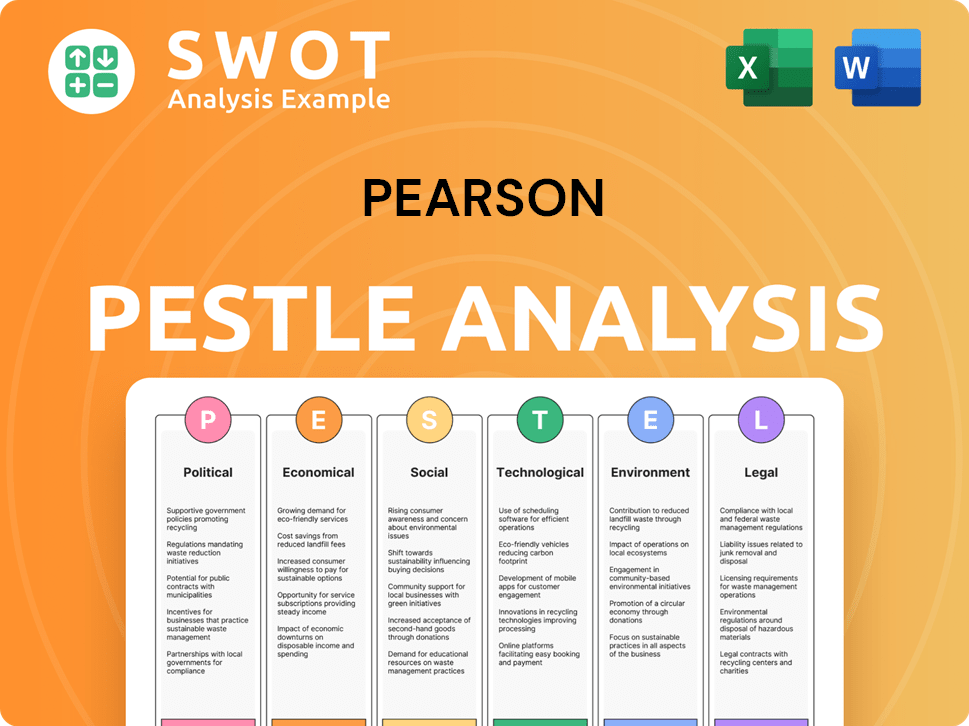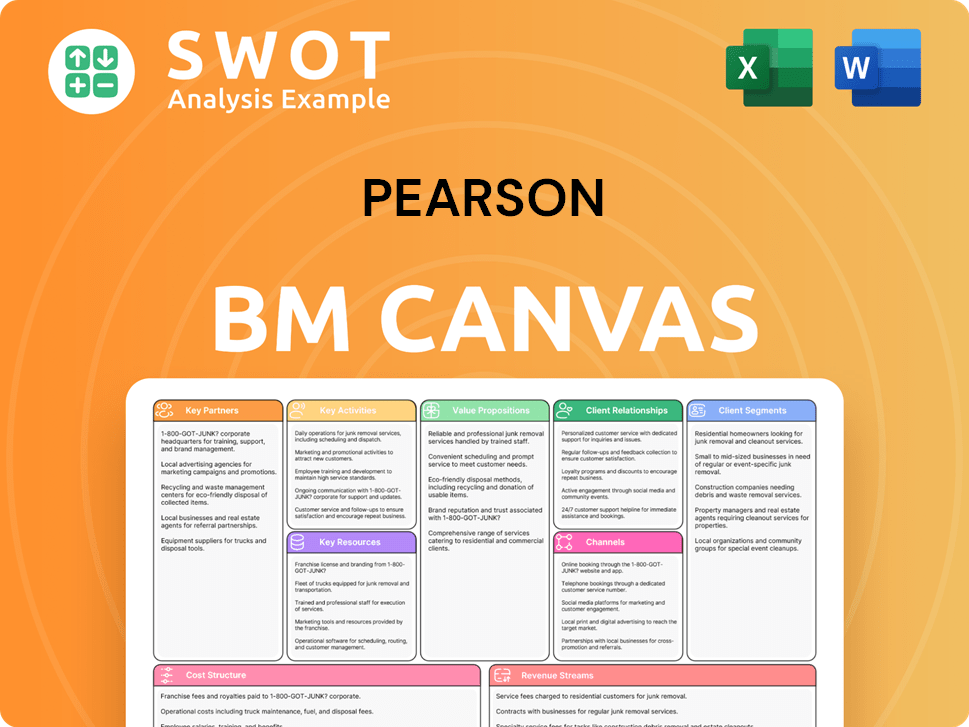Pearson Bundle
Can Pearson Navigate the Future of Education?
Pearson, a titan in the education industry, is undergoing a significant transformation, evolving from a traditional print publisher to a digital learning powerhouse. This strategic pivot is critical for its continued relevance and growth within the dynamic EdTech sector. Founded in 1844, Pearson's journey has been marked by pivotal moments, including strategic acquisitions that expanded its reach into educational publishing and assessment.

This Pearson SWOT Analysis provides a comprehensive look into Pearson's strategic initiatives, exploring its ambitious plans for expansion and innovation. We'll examine the company's response to changing educational needs, analyzing its financial performance and long-term growth forecast within the context of evolving education industry trends. Understanding Pearson's future prospects requires a deep dive into its digital transformation strategy and its competitive advantages, offering valuable insights for investors and industry observers alike.
How Is Pearson Expanding Its Reach?
The Pearson growth strategy is centered on aggressive expansion initiatives designed to broaden its reach and diversify revenue streams. A key focus is on virtual learning, with substantial investments in online program management (OPM) and virtual schools. This strategic direction is a response to the growing demand for flexible and accessible education, positioning the company to capitalize on evolving education industry trends.
Pearson's future prospects are also tied to its ability to adapt to the changing needs of the workforce. The company is developing and delivering professional certifications and training programs across various industries to address the increasing demand for upskilling and reskilling. This focus on workforce skills is a critical element of its growth strategy, ensuring relevance in a rapidly changing job market. For a deeper understanding of how the company generates revenue, you can refer to Revenue Streams & Business Model of Pearson.
Geographical expansion, particularly in emerging markets, is another significant aspect of Pearson company analysis. The company aims to extend its presence in regions like Asia, Africa, and Latin America, tailoring its offerings to local educational requirements. Simultaneously, Pearson is exploring new business models, such as subscription-based services, to broaden its customer base and boost recurring revenue. These initiatives aim to diversify Pearson's revenue streams beyond traditional textbook sales.
Pearson is actively investing in online program management (OPM) and virtual schools. This includes partnerships with universities to deliver online degree programs. This strategy aligns with the rising demand for flexible and accessible education, driving Pearson's digital transformation strategy.
The company is developing professional certifications and training programs. This initiative focuses on upskilling and reskilling across various industries. This responds to the evolving needs of the job market, ensuring Pearson's relevance in the learning solutions market.
Pearson is targeting emerging markets, including Asia, Africa, and Latin America. The company is adapting its offerings to local educational needs and regulatory environments. This strategy is designed to extend its global footprint and tap into new growth opportunities.
Exploring subscription-based services and direct-to-consumer offerings. This aims to broaden the customer base and increase recurring revenue. This diversification is a key to mitigating risks associated with traditional textbook sales, which have faced headwinds.
Pearson's expansion initiatives cover several key areas, including virtual learning, workforce skills, and geographical growth. These strategies are designed to enhance Pearson's financial performance and secure its position in the market. The company's focus on digital product development and vocational education services is expected to drive future growth.
- Virtual Learning: Partnerships with universities and expansion of virtual school offerings.
- Workforce Skills: Development of professional certifications and training programs.
- Geographical Expansion: Targeting emerging markets in Asia, Africa, and Latin America.
- New Business Models: Subscription-based services and direct-to-consumer offerings.
Pearson SWOT Analysis
- Complete SWOT Breakdown
- Fully Customizable
- Editable in Excel & Word
- Professional Formatting
- Investor-Ready Format

How Does Pearson Invest in Innovation?
The growth trajectory of the company is significantly shaped by its innovation and technology strategy, which centers on leveraging digital solutions to enhance learning outcomes and operational efficiency. This approach is critical for navigating the dynamic landscape of the education industry and capitalizing on emerging opportunities. The company's strategic initiatives are designed to meet the evolving needs of learners and educators worldwide.
A core element of the company's strategy involves substantial investments in research and development, both internally and through collaborations, to develop cutting-edge educational platforms and tools. This commitment to innovation is reflected in its drive toward digital transformation. The shift from traditional print to fully integrated digital learning experiences is a key focus, ensuring that the company remains at the forefront of the learning solutions market. This digital-first approach is vital for sustaining long-term growth and maintaining a competitive edge.
The company's digital transformation strategy includes the development of AI-powered adaptive learning platforms, which personalize content and assessments for individual learners. This personalized approach aims to improve learning efficacy and accessibility. Furthermore, the integration of data analytics provides insights into student performance, enabling improvements in pedagogical approaches. This data-driven approach is crucial for optimizing educational outcomes and enhancing the overall learning experience.
The company is moving from traditional print to fully integrated digital learning experiences. This shift includes AI-powered adaptive learning platforms and data analytics integration.
AI-powered adaptive learning platforms personalize content and assessments. Data analytics provide insights into student performance, improving pedagogical approaches.
The company automates assessment services to streamline grading and feedback. This includes the use of AI-driven assessment tools to improve efficiency.
Exploration of virtual reality (VR) and augmented reality (AR) for immersive learning environments. These technologies are particularly useful in subjects requiring practical application.
Integration of sustainability into digital product development. This includes creating more environmentally friendly and accessible learning solutions.
Continuous evolution of Pearson+ offering e-textbooks and study tools. This demonstrates a commitment to digital-first solutions and enhanced accessibility.
The company's technology strategy also extends to the automation of its assessment services, aiming to streamline grading and feedback processes. This includes the use of AI-driven assessment and tutoring tools, which are designed to improve learning efficacy and accessibility. Furthermore, the company is exploring the potential of emerging technologies such as virtual reality (VR) and augmented reality (AR) to create immersive learning environments, particularly in subjects requiring practical application. Sustainability initiatives are also being integrated into their digital product development, aiming for more environmentally friendly and accessible learning solutions. Key to their strategy is the continuous evolution of their Pearson+ subscription service, which offers access to e-textbooks and study tools, demonstrating their commitment to digital-first solutions. Their leadership in innovation is also evidenced by their continued investment in AI-driven assessment and tutoring tools, aiming to improve learning efficacy and accessibility. This approach aligns with the company's broader mission, as detailed in Mission, Vision & Core Values of Pearson.
The company's strategic initiatives focus on digital transformation, AI integration, and sustainability. These strategies are designed to enhance learning outcomes and operational efficiency, driving the company's future prospects.
- Digital Learning Platforms: Development and enhancement of digital learning platforms, including AI-powered adaptive learning systems.
- AI-Driven Assessment: Implementation of AI in assessment processes to improve efficiency and provide personalized feedback.
- Emerging Technologies: Exploration and integration of VR and AR to create immersive learning experiences.
- Sustainability: Incorporation of sustainable practices in digital product development to reduce environmental impact.
- Pearson+ Subscription Service: Continuous improvement of the Pearson+ platform to offer comprehensive digital learning resources.
Pearson PESTLE Analysis
- Covers All 6 PESTLE Categories
- No Research Needed – Save Hours of Work
- Built by Experts, Trusted by Consultants
- Instant Download, Ready to Use
- 100% Editable, Fully Customizable

What Is Pearson’s Growth Forecast?
The financial outlook for Pearson is largely shaped by its strategic focus on digital products and services, which is a key element of its Pearson growth strategy. Recent financial reports show a strong performance in this area, indicating a successful transition towards a digital-first approach. For the full year 2023, the company demonstrated positive momentum with an adjusted operating profit of £573 million, a notable increase from £474 million in 2022, reflecting enhanced profitability.
The company's revenue for 2023 was £3,721 million, showcasing consistent performance and stability. This financial strength supports its future growth plans, including investments in digital product development, strategic acquisitions, and market expansion. Pearson aims for sustainable growth by diversifying revenue streams and capitalizing on the high-margin potential of its digital offerings and assessment services, which are crucial for understanding Pearson future prospects.
Looking ahead to 2024, Pearson anticipates an adjusted operating profit between £530 million and £580 million, with a continued emphasis on cash generation. This financial strategy is designed to support the company's growth ambitions and return value to shareholders. Analysts' forecasts generally align with Pearson's positive outlook, acknowledging its strong market position in the evolving education sector and its successful pivot to digital, which is a critical aspect of Pearson company analysis.
The company's revenue growth is primarily driven by its digital products and services, which are increasingly popular in the learning solutions market. Strategic acquisitions and partnerships also contribute to revenue growth by expanding the company's reach and offerings. The shift towards online learning and assessment tools is a significant factor, aligning with current education industry trends.
Key financial indicators include adjusted operating profit and revenue, which have shown positive trends in recent years. The company's strong cash flow generation is another important metric, supporting its ability to invest in future growth initiatives. Pearson financial performance is closely monitored by analysts, who assess the company's ability to adapt to changing market conditions.
Pearson's investment strategy focuses on digital product development, strategic acquisitions, and market expansion. The company is actively exploring opportunities in emerging markets to broaden its global footprint. These initiatives are part of Pearson's strategic initiatives 2024, aimed at solidifying its position in the education sector.
The company's Pearson's digital transformation strategy involves enhancing its digital offerings and platforms to meet the evolving needs of learners. This includes investing in AI for education and developing innovative learning solutions. The focus is on creating personalized and engaging learning experiences through digital tools and resources.
The company's financial health is also supported by its ability to generate strong cash flows, which enables it to fund future growth initiatives and return value to shareholders. Further insights into the company's strategy can be found in an article discussing the Pearson's competitive advantages and disadvantages.
Pearson maintains a significant Pearson's market share in online learning, particularly in the higher education and professional certification segments. The competitive landscape includes both established players and emerging digital education providers. The company's ability to innovate and adapt to market changes is essential for maintaining its competitive edge.
Pearson's expansion into emerging markets is a key part of its growth strategy, focusing on regions with high growth potential in education. This involves adapting its products and services to meet the specific needs of these markets. The company's global presence allows it to capitalize on opportunities in diverse educational settings.
Pearson significantly impacts Pearson's impact on global education through its educational resources and assessment services. The company's products are used by millions of learners worldwide, influencing educational standards and practices. Its focus on digital learning solutions is helping to shape the future of education.
Pearson's sustainability initiatives include efforts to reduce its environmental impact and promote social responsibility. The company is committed to sustainable practices in its operations and supply chain. These initiatives are increasingly important to stakeholders and contribute to the company's long-term value.
The Pearson's long-term growth forecast is positive, driven by the increasing demand for digital learning solutions and assessment services. The company's ability to innovate and adapt to market changes is essential for its continued success. Analysts project steady growth, supported by strategic investments and market expansion.
Pearson's partnerships and acquisitions are strategic moves designed to enhance its product offerings and expand its market reach. The company actively seeks opportunities to collaborate with other educational institutions and technology providers. These partnerships are crucial for driving innovation and growth.
Pearson Business Model Canvas
- Complete 9-Block Business Model Canvas
- Effortlessly Communicate Your Business Strategy
- Investor-Ready BMC Format
- 100% Editable and Customizable
- Clear and Structured Layout

What Risks Could Slow Pearson’s Growth?
The future of the company, like any major player in the education industry trends, is not without its challenges. Several potential risks and obstacles could affect its growth and market position. Understanding these challenges is crucial for investors and stakeholders analyzing the Pearson company analysis.
The company faces intense competition from both established and emerging players in the learning solutions market. Constant innovation and adaptation are essential to maintain its leading position. Regulatory changes, especially concerning data privacy and accessibility in education, require significant adjustments to products and services. Furthermore, the rapid evolution of technology continues to pose a threat, demanding continuous investment in research and development.
Supply chain disruptions, while less severe than in some sectors, and internal resource constraints, such as the availability of skilled talent, can also hinder progress. The company addresses these challenges through a diversified product portfolio and robust risk management. The company's proactive approach includes accelerating its digital transformation and divesting non-core assets, as highlighted in the article about Marketing Strategy of Pearson.
The Pearson growth strategy is challenged by a competitive landscape, including EdTech startups and tech giants. This competition necessitates ongoing innovation and differentiation to maintain market share. The company must continually evolve its offerings to stay ahead of the curve.
Regulatory changes in education, especially regarding data privacy and accessibility, pose a risk. These changes require significant adaptation of the company's products and services. Compliance with evolving standards demands constant attention and investment.
Technological advancements can quickly make existing platforms or content obsolete. The company mitigates this by investing heavily in research and development. This proactive approach is crucial to staying relevant in a rapidly changing environment.
Internal resource constraints, such as skilled talent in AI and digital development, could hinder growth. Addressing these constraints is vital for sustaining momentum. Management must focus on attracting and retaining top talent.
The rapid evolution of generative AI presents both opportunities and risks. The company is actively exploring ways to leverage AI in content creation and assessment. This proactive approach is crucial for future success.
Supply chain vulnerabilities can affect the timely delivery of educational materials. While less pronounced than in manufacturing, this remains a factor. Effective supply chain management is essential for operational efficiency.
The company is focused on accelerating its digital transformation. This includes a shift from print to digital offerings. The company is also actively divesting non-core assets to streamline operations. These initiatives are designed to enhance Pearson's financial performance.
The company is investing heavily in digital platforms and content. This includes developing online learning solutions. This strategy aims to improve Pearson's market share in online learning. The company is also exploring AI integration to enhance its offerings.
Pearson Porter's Five Forces Analysis
- Covers All 5 Competitive Forces in Detail
- Structured for Consultants, Students, and Founders
- 100% Editable in Microsoft Word & Excel
- Instant Digital Download – Use Immediately
- Compatible with Mac & PC – Fully Unlocked

Related Blogs
- What are Mission Vision & Core Values of Pearson Company?
- What is Competitive Landscape of Pearson Company?
- How Does Pearson Company Work?
- What is Sales and Marketing Strategy of Pearson Company?
- What is Brief History of Pearson Company?
- Who Owns Pearson Company?
- What is Customer Demographics and Target Market of Pearson Company?
Disclaimer
All information, articles, and product details provided on this website are for general informational and educational purposes only. We do not claim any ownership over, nor do we intend to infringe upon, any trademarks, copyrights, logos, brand names, or other intellectual property mentioned or depicted on this site. Such intellectual property remains the property of its respective owners, and any references here are made solely for identification or informational purposes, without implying any affiliation, endorsement, or partnership.
We make no representations or warranties, express or implied, regarding the accuracy, completeness, or suitability of any content or products presented. Nothing on this website should be construed as legal, tax, investment, financial, medical, or other professional advice. In addition, no part of this site—including articles or product references—constitutes a solicitation, recommendation, endorsement, advertisement, or offer to buy or sell any securities, franchises, or other financial instruments, particularly in jurisdictions where such activity would be unlawful.
All content is of a general nature and may not address the specific circumstances of any individual or entity. It is not a substitute for professional advice or services. Any actions you take based on the information provided here are strictly at your own risk. You accept full responsibility for any decisions or outcomes arising from your use of this website and agree to release us from any liability in connection with your use of, or reliance upon, the content or products found herein.